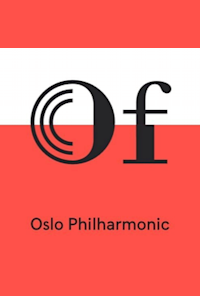Elgar and Tchaikovsky
Vilde Frang plays Elgar’s spectacular Violin Concerto as part of the opening week of the Oslo Philharmonic Orchestra’s centenary anniversary.
Elgar’s Violin Concerto is still a rare pearl in the Romantic repertoire. The same cannot be said for Tchaikovsky’s Symphony No. 5 − one of the cornerstones of the Russian symphonic repertoire and a historic signature piece for the Oslo Philharmonic Orchestra through a century. The work opens in a quiet and mysterious fashion, with the clarinet’s “fate” motive, but soon, the most beautiful melodies in the world are let loose, coupled with the most magnificent orchestral sound.
Tchaikovsky’s fifth symphony has always had a special resonance in the orchestra. The work was performed during its very first season, and has proved remarkably popular among musicians, conductors and audiences in Oslo since the 1920’s. Half a century later, Tchaikovsky’s symphonies were in focus when the Oslo Philharmonic first achieved international recognition. Recordings of the fourth, fifth and sixth symphonies with Mariss Jansons in the 1980’s won numerous awards, granting the orchestra a new presence on the international music scene.
The theme of the clarinet, in a dark minor key, accompanied by deeply solemn strings, heralds a tragic fate in the opening of Pyotr Ilyich Tchaikovsky’s (1840−1893) fifth symphony. Constructed in the same fashion as Beethoven’s fifth symphony, the theme goes from battle to triumph, from darkness to light, in the course of the symphony. The drama remains even after the triumph is seemingly achieved in the beginning of the finale, and the theme is no longer in a minor key, but in a radiant major key. Threatening fate is defeated in the end, and the symphony ends in triumph. When the work was completed in 1888, Tchaikovsky’s might have realised that fate was not so merciful, something which was to colour his heartrending sixth symphony a few years later. Tchaikovsky concealed his sexuality throughout his life, and died an unhappy man in 1893. The cause of death was cholera, but many have speculated on whether his early death was by his own hand.
Although his fifth symphony has a dramatic form and a clearly drawn plot, features most people remember most clearly are its beautiful melodies, rich orchestra sound and many expressive highlights. Who could forget the master of ballet’s beautiful waltz in the third movement, the elegant horn solo and the rich orchestra palate in the famous second movement − not to speak of the expressive musical waves sweeping through the entire work?
The fifth symphony was in no way an immediate success. Critics were sceptical after its world premiere in St. Petersburg in 1888 and Tchaikovsky even described the work as a fiasco after having conducted it in Prague. Since then, however, it has assumed a clear position in the international standard concert repertoire and remains one of our time’s most often performed and best-known Russian symphonies − irrespective of composer and era.
There are many demanding solo concertos in a violinist’s repertoire, but many still count Edward Elgar’s (1857−1934) Violin Concerto as one of the most challenging. The soloist is thrown into a furious race and is obliged to battle with demanding string transitions and double stops throughout all three movements. Originally, the concerto was composed for legendary violinist Fritz Kreisler, who performed the world premiere in London in 1910. Kreisler respected Elgar’s work highly, and stated in an interview from 1905 that he regarded Elgar as one of the very greatest living composers of his time. Elgar had a habit of embedding riddles in his own work, and in his Violin Concerto, he added the mysterious note “Here lies the soul of .....” It has been speculated on whether the five dots might symbolise the composer’s close friend Alice, while others think that the concerto is so expressive and personal that Elgar must have buried his own soul in the work.
The Violin Concerto consists of three movements and opens with an intense and long orchestra prelude where many of the work’s most important melodic ideas are introduced. After a while the soloist enters and instantly strikes up an animated dialogue with the orchestra. In the course of this movement, the soloist has the chance to show off her virtuosity to the full. The second movment has a slower tempo, but maintains the same intensity and expressivity as the preceding movements. Elgar himself said “It’s good! Awfully emotional! Too emotional, but I love it”. The finale opens with cadenza-like cascades from the soloist and untamed solo passages. Exactly when one thinks the movement is on its way to some sort of bravura ending, Elgar surprises the listener by drawing the tempo and expression down into a longer cadenza passage, before arriving at the definitive and breathless conclusion of the work.

